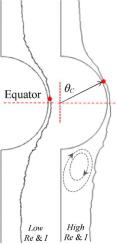当前位置:
X-MOL 学术
›
Miner. Eng.
›
论文详情
Our official English website, www.x-mol.net, welcomes your
feedback! (Note: you will need to create a separate account there.)
Effect of microturbulence on bubble-particle collision during the bubble rise in a flotation cell
Minerals Engineering ( IF 4.9 ) Pub Date : 2020-08-01 , DOI: 10.1016/j.mineng.2020.106418 Md. Tariqul Islam , Anh V. Nguyen
Minerals Engineering ( IF 4.9 ) Pub Date : 2020-08-01 , DOI: 10.1016/j.mineng.2020.106418 Md. Tariqul Islam , Anh V. Nguyen

|
Abstract Holistically, air bubbles in flotation must rise to the top surface while free solid particles must settle to the cell bottom. Inside the stator-rotor space of the mechanical flotation cells, the turbulence of mixing can surpass the gravity-driven motion of the bubble-particle suspension. Outside the space, the bubbles rise to the surface, but it is not known how the turbulence affects the bubble-particle interaction during the bubble rise. Here we numerically investigate the effect of microturbulence on the bubble-particle collision during the bubble rise. The focus is on the interaction asymmetry caused by the inertial forces and bubbles with fully mobile (MBS) or immobile (IMBS) surfaces at intermediate bubble Reynolds number (Re). The Reynolds-Averaged Navier-Stokes equations with the RNG k-ɛ turbulence model are solved for the mean water flow. Its fluctuating components are predicted using the stochastic formulation that is adopted with the discrete phase formulation for determining the particle grazing trajectories. The results show microturbulence influences the bubble-particle collision interaction. The asymmetry of the collision interaction is also affected by the microturbulence intensity. Its negative effects are found for the CCA (the critical collision angle, which also affects the bubble-particle attachment) and the overall collision efficiency. These negative effects are unexpected because turbulence has been postulated to enhance the collision interaction. Numerical results agree with the MBS model for overall collision efficiency and show some significant deviations for the IMBS model. This paper provides a potential technique to examine the microturbulence effect on attachment efficiency via the CCA.
中文翻译:

浮选槽气泡上升过程中微湍流对气泡-颗粒碰撞的影响
摘要 从整体上讲,浮选中的气泡必须上升到顶部表面,而游离的固体颗粒必须沉降到池底部。在机械浮选槽的定子-转子空间内,混合的湍流可以超过气泡-颗粒悬浮液的重力驱动运动。在空间外,气泡上升到表面,但不知道在气泡上升过程中湍流如何影响气泡-颗粒相互作用。在这里,我们数值研究了气泡上升过程中微湍流对气泡-粒子碰撞的影响。重点是由惯性力和气泡在中间气泡雷诺数 (Re) 下具有完全移动 (MBS) 或固定 (IMBS) 表面引起的相互作用不对称性。使用 RNG k-ɛ 湍流模型求解雷诺平均 Navier-Stokes 方程以获得平均水流。使用随机公式预测其波动分量,该公式与离散相公式一起用于确定粒子掠过轨迹。结果表明微湍流影响气泡-粒子碰撞相互作用。碰撞相互作用的不对称性也受微湍流强度的影响。它对 CCA(临界碰撞角,也影响气泡-粒子附着)和整体碰撞效率有负面影响。这些负面影响是出乎意料的,因为已经假设湍流会增强碰撞相互作用。数值结果与 MBS 模型的整体碰撞效率一致,并显示出 IMBS 模型的一些显着偏差。本文提供了一种潜在的技术,可以通过 CCA 检查微湍流对附着效率的影响。
更新日期:2020-08-01
中文翻译:

浮选槽气泡上升过程中微湍流对气泡-颗粒碰撞的影响
摘要 从整体上讲,浮选中的气泡必须上升到顶部表面,而游离的固体颗粒必须沉降到池底部。在机械浮选槽的定子-转子空间内,混合的湍流可以超过气泡-颗粒悬浮液的重力驱动运动。在空间外,气泡上升到表面,但不知道在气泡上升过程中湍流如何影响气泡-颗粒相互作用。在这里,我们数值研究了气泡上升过程中微湍流对气泡-粒子碰撞的影响。重点是由惯性力和气泡在中间气泡雷诺数 (Re) 下具有完全移动 (MBS) 或固定 (IMBS) 表面引起的相互作用不对称性。使用 RNG k-ɛ 湍流模型求解雷诺平均 Navier-Stokes 方程以获得平均水流。使用随机公式预测其波动分量,该公式与离散相公式一起用于确定粒子掠过轨迹。结果表明微湍流影响气泡-粒子碰撞相互作用。碰撞相互作用的不对称性也受微湍流强度的影响。它对 CCA(临界碰撞角,也影响气泡-粒子附着)和整体碰撞效率有负面影响。这些负面影响是出乎意料的,因为已经假设湍流会增强碰撞相互作用。数值结果与 MBS 模型的整体碰撞效率一致,并显示出 IMBS 模型的一些显着偏差。本文提供了一种潜在的技术,可以通过 CCA 检查微湍流对附着效率的影响。











































 京公网安备 11010802027423号
京公网安备 11010802027423号